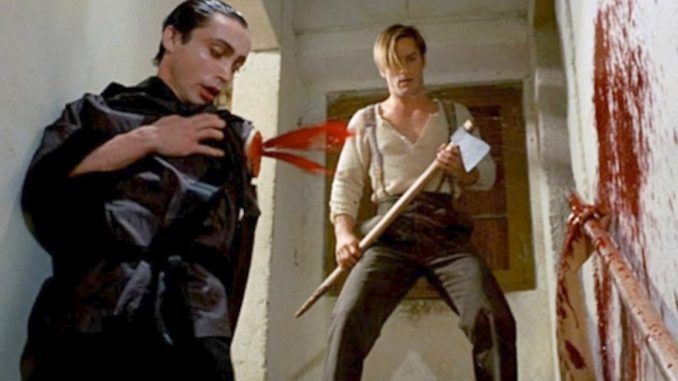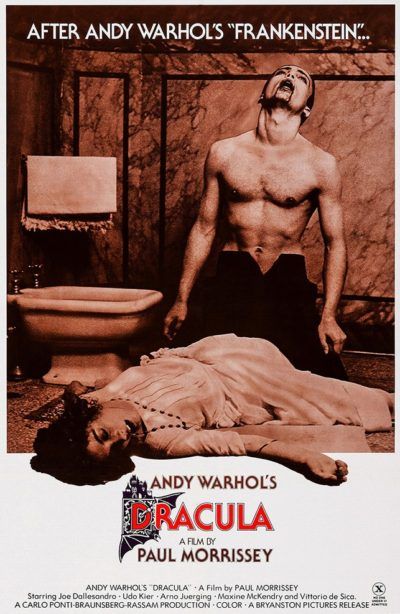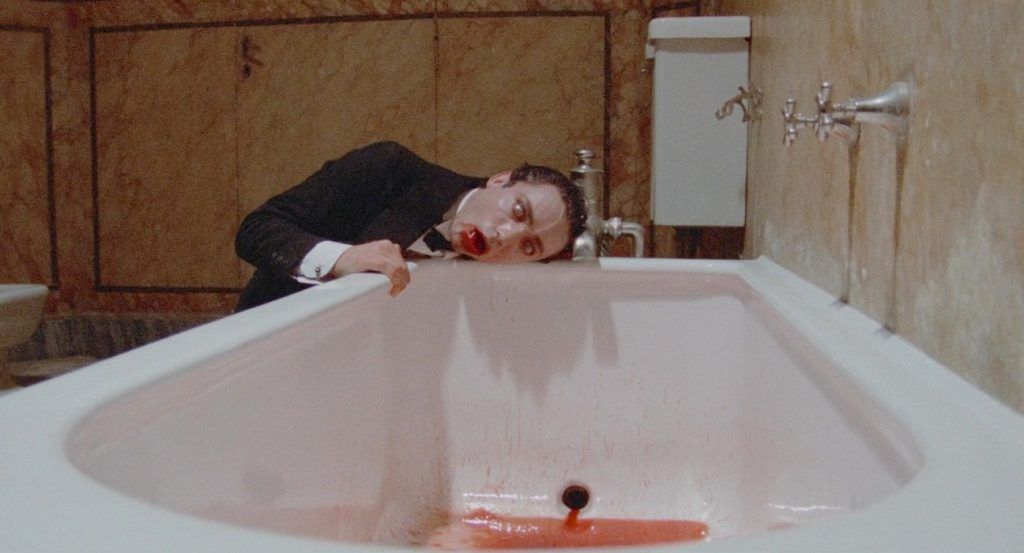
Rating: B
Dir: Paul Morrissey
Star: Udo Kier, Joe Dallesandro, Arno Juerging, Maxime McKendry
a.k.a. Andy Warhol’s Dracula
Though we should first get the alternate title out of the way: when asked how he contributed to this and Andy Warhol’s Frankenstein (a.k.a. Flesh For Frankenstein), the artist said, “I go to the parties.” If you’ve seen any of Warhol’s genuine output – such as 485 minutes silent, b&w footage of the Empire State Building, shot from one spot – his lack of input here probably counts as a good thing. This has a plot, and actual actors… Well, some of them, anyway: I’m not sure I’ve ever seen Dallesandro do much more than recite his lines, and move from one position to another. If he’s feeling brave, occasionally both at the same time. But this is still a memorable work, and to his credit, Dallesandro fits into it, perhaps because he doesn’t fit into it.
This was filmed back-to-back after Frankenstein in Italy, pausing just long enough for Kier to get a haircut. Local director Antonio Margheriti was credited as director there, though this seems to have been largely a tax dodge, in order to qualify for rebates in Italy. Both Margheriti and producer Carlo Ponti (Mr. Sophia Loren), who funded the Morrissey movies, ended up prosecuted for “continued and aggravated fraud against the state.” Unlike its predecessor, Dracula wasn’t shot in 3-D, and in generally, you’d have to call it a considerably more restrained entity. That said, everything is relative. What this may lack, in intestines being energetically waved towards the camera, in order to take advantage of that third dimension, it makes up for in Kier barfing up bad blood.
 Even almost 50 years later, it is still quite transgressive, albeit perhaps due to societal changes. Perhaps the most shocking thing to a contemporary audience would be Dallesandro’s estate worker, Mario Balato, venomously spitting out, “I’d like to rape the hell out of her.” He’s speaking about a fourteen-year-old girl. But then, you sense Morrissey is very much playing everything against type here. I’ve read some critiques of this commenting on its conservative nature, resulting from the way Mario is depicted for example, calling it “a lament for the destruction of traditional societal and moral values.”
Even almost 50 years later, it is still quite transgressive, albeit perhaps due to societal changes. Perhaps the most shocking thing to a contemporary audience would be Dallesandro’s estate worker, Mario Balato, venomously spitting out, “I’d like to rape the hell out of her.” He’s speaking about a fourteen-year-old girl. But then, you sense Morrissey is very much playing everything against type here. I’ve read some critiques of this commenting on its conservative nature, resulting from the way Mario is depicted for example, calling it “a lament for the destruction of traditional societal and moral values.”
But truth be told, nobody here is exactly portrayed in anything approaching a positive light. It’s quite equal opportunity in its cynicism, with those “traditional moral values” hardly endorsed. This begins with its depiction of Count Dracula (Kier), who is possibly the wussiest vampire this side of Edward Cullen. We first see him literally painting himself, in front of a mirror – the joke being, his reflection doesn’t appear in it. At least Drac doesn’t sparkle. But he is the whiny fag-end of his bloodline, as far from the magnificent, feral portrayal of Christopher Lee as imaginable. “Why did you take me on this hopeless journey?”, he cries to loyal man-servant, Anton (Juerging). “Let me go home and die in peace!”, continues the Count before going off on a rant about the greasy cooking habits of Italians.
The trip is necessary because of the lack of appropriate food in his native Romania. He and his sister have exhausted the local supply of virgins – or as Kier pronounces it with relish, “wur-jeens” – so he needs to forage further afield. Italy seems like a good spot, Anton feeling the strong Catholic influence will mean plenty of pure blood sources for the Count. They stop in a small town, and learn of the local nobility, Il Marchese di Fiore (renowned director Vittorio de Sica), whose family has fallen on hard times. Dracula’s wealth and their four daughters would seem to present an excellent chance for a match that’d give both parties what they want. If not, perhaps, the bride.
The fly in the ointment is Mario, who has already rescued two of the four daughters from their virginities. He’s not exactly your typical vampire hunter either. An unrepentant Marxist, he’s driven by a mix of animalistic lust and crass class hatred. “You’re going to be on the bottom. It’ll be just like Russia,” he snorts with disdain at one of the daughters. Dallesandro makes no attempt to tone down his Noo Yawk accent, and sounds like he should be a stevedore or a meat-packer. He’s really the least unconvincing Italian peasant of all-time. In contrast, the Marchesa (McKendry) is top-shelf posh English, though I guess she could have married into the family. McKendry, incidentally, had a fascinating life which included working as a code breaker at Bletchley Park in the war, before being discharged for kleptomania, and becoming the occasional cook for Warhol’s Factory crowd.
 Dracula reacts badly to blood from the non-virgin sisters, literally turning green and throwing it back up (above). He then begins circling the youngest daughter, Perla, figuring her tender age guarantees her purity. But Mario discovers the coffin the Count brought doesn’t contain the body of an uncle who died in Rome, as claimed. He then “saves” Perla by making good on his earlier promise, and raping her (at least Silvia Dionisio, the actress playing Perla, was well into her twenties). She ends up liking it, naturally, because she and her sisters are, to quote Mario “hoo-ers”. It doesn’t get much more Noo Yawk than that. He then goes after Dracula with an ax, lopping off each limb in a very Black Knight fashion (top), before staking the torso.
Dracula reacts badly to blood from the non-virgin sisters, literally turning green and throwing it back up (above). He then begins circling the youngest daughter, Perla, figuring her tender age guarantees her purity. But Mario discovers the coffin the Count brought doesn’t contain the body of an uncle who died in Rome, as claimed. He then “saves” Perla by making good on his earlier promise, and raping her (at least Silvia Dionisio, the actress playing Perla, was well into her twenties). She ends up liking it, naturally, because she and her sisters are, to quote Mario “hoo-ers”. It doesn’t get much more Noo Yawk than that. He then goes after Dracula with an ax, lopping off each limb in a very Black Knight fashion (top), before staking the torso.
It’s all ridiculous, yet there’s a lot to enjoy, in particular the quirky set of performances. These work as an ensemble better than in isolation; it’s easy to accept the Marchesa and her four daughters are related, for example. I loved Juerging too, who has to be one of the best vampire servants in cinema history. It’s a shame he never appeared in much else. As well as de Sica, Roman Polanski has a cameo as the peasant who hoodwinks Anton in the village inn. I think it may be a better film than Flesh For Frankenstein, though I’m not sure it is quite as entertaining.
This review is part of our October 2023 feature, 31 Days of Vampires.
